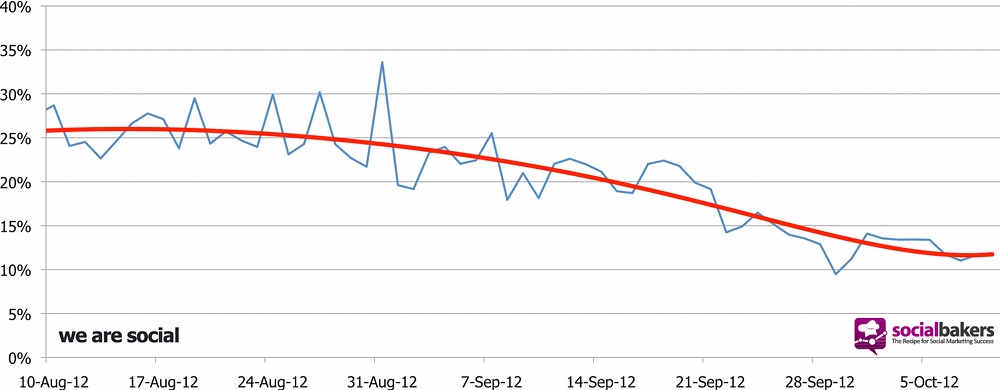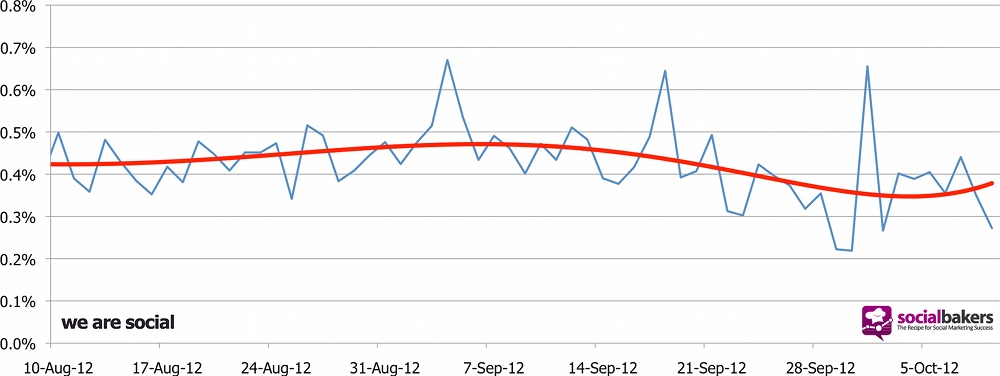How to react to halved reach on Facebook
New research shows that Facebook has halved the reach of brands’ Facebook page posts, with the result that fans will still see the most engaging posts from brands, but will be much less likely to see the less engaging ones.
With Facebook saying “all content should be as engaging as the posts you see from friends and family”, brands will need to change their social content strategies, spending more on better, higher value posts which resonate with their community, complemented with paid promotion.
The story started two weeks ago with an unverified report that Facebook has changed its EdgeRank algorithm to reduce the amount of brands’ Facebook page posts seen in fans’ newsfeeds, suggesting the reach of posts would decrease by anywhere between 5% – 40%.
On Monday last week came the first independent verification of the change, with a study looking at 3,000 Facebook pages, showing a 20% drop in the reach of those pages.
To find out what was going on, and to see how things have developed since then, I turned to We Are Social’s friends and partners at Socialbakers to pull some data.

Average post organic reach 10th Aug- 9th Oct, based on 15,380 posts made by the 157 of the most active commercial pages in the period.
As you can see, there seems to have been a significant decline in reach since the end of August. Meaning the average post reach has dropped by around 50% to an average of around 12%.
The precise drop in reach that any of your pages will have experienced will of course vary – previous to this change in EdgeRank, reach ranged from an average of 33% for pages with less than 500 fans all the way down to 5.6% for pages with over a million fans.
Looking at the average page post engagement rate, it seems to have fluctuated slightly, but broadly it’s still tracking around the 0.4% level:

Average post engagement rate 10th Aug- 9th Oct, based on 15,380 posts made by the 157 of the most active commercial pages in the period.
In order for the average engagement rate to stay stable while the average post reach has reduced by 50%, this must mean that the posts that are getting seen by fans are now getting more engagement.
So what’s going on? Is this a cynical ploy by Facebook to boost advertising revenue from brands? Or an understandable adjustment to compensate for the growing number of pages that people are fans of, and the increased activity of those pages?
All Facebook will publically say on the issue is:
We’re continuing to optimize News feed to show the posts that people are most likely to engage with, ensuring they see the most interesting stories. This aligns with our vision that all content should be as engaging as the posts you see from friends and family.
Based on that statement and what we see from Socialbakers’ data, it’s clear that Facebook have indeed changed their EdgeRank algorithm to reduce the amount of brands’ Facebook page posts seen in fans’ newsfeeds.
More specifically, they’re trying to do so in a way that fans still see brands’ most engaging posts, but are much less likely see the less engaging ones.
EdgeRank has always worked in this way, but now it’s been turbocharged and brands are competing for a much smaller ‘share of newsfeed’, so optimizing your posts for engagement is now even more important.
Reduced organic reach, combined with Facebook’s recent evidence that “reach drives revenue for online brand marketers,” means boosting the reach of your posts with Facebook media spend is essential – but remember it’s the engaging posts that will perform better. Sponsoring posts which are not engaging is a waste of your money.
As a result, brands will need to change their social content strategies, spending more on better, higher value posts which resonate with their community. Or as we say at We Are Social, content OF the people, not AT the people.
The time when brands could get by on Facebook by buying fans and basic community management is well and truly over. Facebook’s changes mean brands need to shift to creating social content that is “as engaging as the posts you see from friends and family” and supplement this with a sophisticated paid promotion strategy. And unless they have these skills in house, they will need the help of specialist social agencies with the ability to create this engaging content and plan media against it.
Update: Facebook have published the following article, News Feed, Engagement, and Promoted Posts: How They Work, which tries to explain their side of the story, and a whitepaper, Understanding Paid and Earned Reach on Facebook, which shows that brands can reach on average 5x more people using paid media in addition to organic publishing.